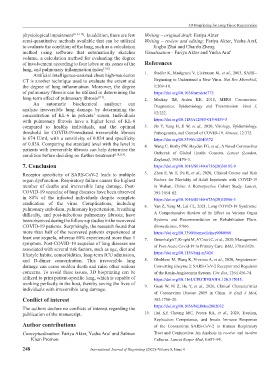Page 256 - IJB-8-4
P. 256
3D Bioprinting for Lung Tissue Regeneration
physiological impairment [113-115] . In addition, there are few Writing – original draft: Fariya Akter
semi-quantitative methods available that can be utilized Writing – review and editing: Fariya Akter, Yusha Araf,
to evaluate the condition of the lung, such as a calculation Jingbo Zhai and Chunfu Zheng
method using software that automatically sketches Visualization - Fariya Akter and Yusha Araf
volume, a calculation method for evaluating the degree
of involvement according to four lobes or six zones of the References
lung, and pulmonary inflammation index [116] .
Artificial intelligence-assisted chest high-resolution 1. Stadler K, Masignani V, Eickmann M, et al., 2003, SARS--
CT is another technique used to evaluate the extent and Beginning to Understand a New Virus. Nat Rev Microbiol,
the degree of lung inflammation. Moreover, the degree 1:209–18.
of pulmonary fibrosis can be utilized in determining the https://doi.org/10.1038/nrmicro775
long-term effect of pulmonary fibrosis [117] . 2. Mackay IM, Arden KE, 2015, MERS Coronavirus:
An automatic biochemical analyzer can Diagnostics, Epidemiology and Transmission. Virol J,
analyze irreversible lung damage by determining the
concentration of KL-6 in patients’ serum. Individuals 12:222.
with pulmonary fibrosis have a higher level of KL-6 https://doi.org/10.1186/s12985-015-0439-5
compared to healthy individuals, and the optimal 3. Jin Y, Yang H, Ji W, et al., 2020, Virology, Epidemiology,
threshold for COVID-19-mediated irreversible fibrosis Pathogenesis, and Control of COVID-19. Viruses, 12:372.
is 674 U/ml, with a sensitivity of 0.824 and specificity https://doi.org/10.3390/v12040372
of 0.838. Comparing the standard level with the level in 4. Wang C, Horby PW, Hayden FG, et al., A Novel Coronavirus
patients with irreversible fibrosis can help determine the Outbreak of Global Health Concern. Lancet (London,
condition before deciding on further treatment [118,119] .
England), 395:470–3.
7. Conclusion https://doi.org/10.1016/S0140-6736(20)30185-9
Receptor specificity of SARS-CoV-2 leads to multiple 5. Zhou F, Yu T, Du R, et al., 2020, Clinical Course and Risk
organ dysfunction. Respiratory failure causes the highest Factors for Mortality of Adult Inpatients with COVID-19
number of deaths and irreversible lung damage. Post- in Wuhan, China: A Retrospective Cohort Study. Lancet,
COVID-19 sequelae of lung diseases have been observed 395:1054–62.
in 80% of the infected individuals despite complete https://doi.org/10.1016/S0140-6736(20)30566-3
eradication of the virus. Complications, including 6. Yan Z, Yang M, Lai CL, 2021, Long COVID-19 Syndrome:
pulmonary embolism, pulmonary hypertension, breathing
difficulty, and post-infectious pulmonary fibrosis, have A Comprehensive Review of its Effect on Various Organ
been observed during the follow-up studies in the recovered Systems and Recommendation on Rehabilitation Plans.
COVID-19 patients. Surprisingly, the research found that Biomedicines, 9:966.
more than half of the recovered patients experienced at https://doi.org/10.3390/biomedicines9080966
least one sequela, whereas 60% experienced more than 1 7. Greenhalgh T, Knight M, A’Court C, et al., 2020, Management
symptom. Post-COVID-19 sequelae of lung diseases are of Post-Acute Covid-19 in Primary Care. BMJ, 370:m3026.
associated with several risk factors, such as age, diet and
lifestyle habits, comorbidities, long-term ICU admission, https://doi.org/10.1136/bmj.m3026
and D-dimer concentration. This irreversible lung 8. Gheblawi M, Wang K, Viveiros A, et al., 2020, Angiotensin-
damage can cause sudden death and raise other serious Converting Enzyme 2: SARS-CoV-2 Receptor and Regulator
concerns. To avoid these issues, 3D bioprinting can be of the Renin-Angiotensin System. Circ Res, 126:1456-74.
utilized to print patient-specific lung, which is capable of https://doi.org/10.1161/CIRCRESAHA.120.317015.
working perfectly in the host, thereby saving the lives of 9. Guan W, Ni Z, Hu Y, et al., 2020, Clinical Characteristics
individuals with irreversible lung damage.
of Coronavirus Disease 2019 in China. N Engl J Med,
Conflict of interest 382:1708–20.
The authors declare no conflicts of interest regarding the https://doi.org/10.1056/NEJMoa2002032
publication of the manuscript. 10. Hui KP, Cheung MC, Perera RA, et al., 2020, Tropism,
Replication Competence, and Innate Immune Responses
Author contributions of the Coronavirus SARS-CoV-2 in Human Respiratory
Conceptualization: Fariya Akter, Yusha Araf and Salman Tract and Conjunctiva: An Analysis in ex-vivo and in-vitro
Khan Promon Cultures. Lancet Respir Med, 8:687–95.
248 International Journal of Bioprinting (2022)–Volume 8, Issue 4

